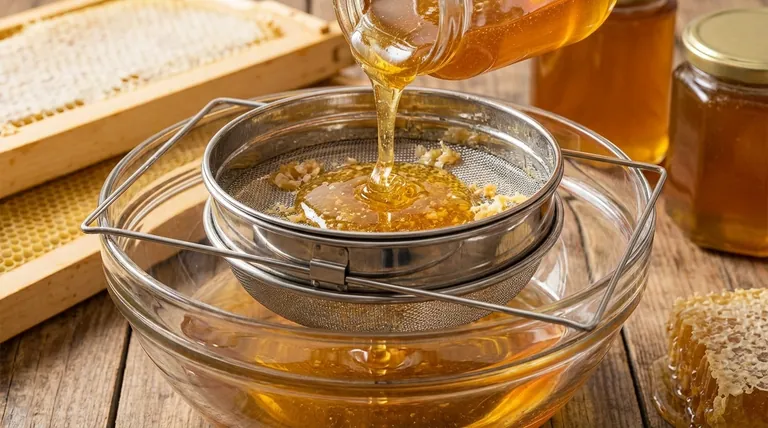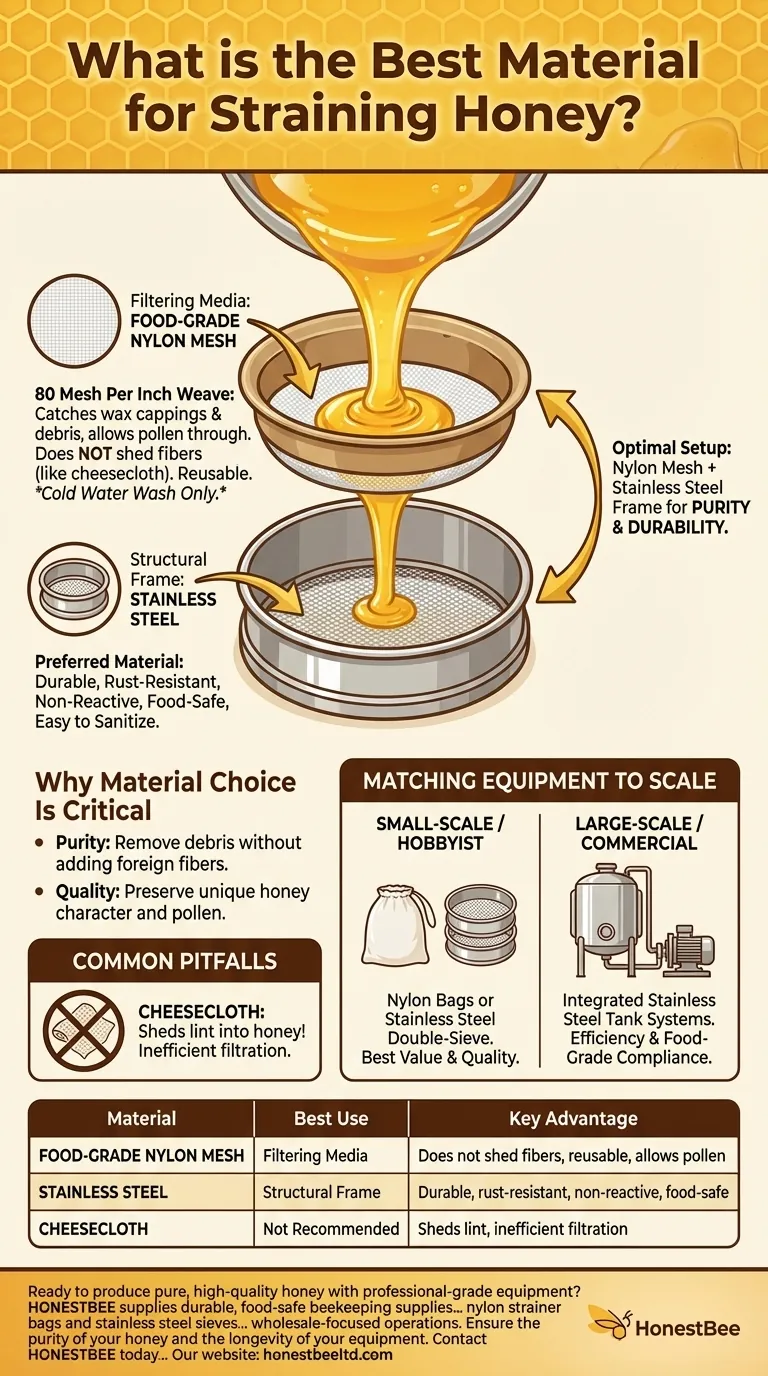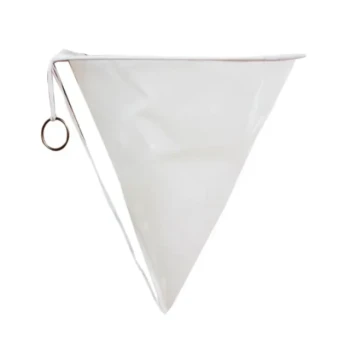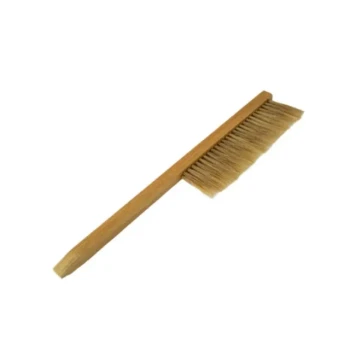The best material for straining honey is a food-grade nylon mesh. This material provides the ideal balance of filtration efficiency and purity, effectively removing wax cappings and hive debris without introducing foreign fibers. For the strainer's structural body, stainless steel is the professional standard due to its durability and food-safe properties.
The optimal honey straining setup combines two materials for two different purposes: a fine nylon mesh for the actual filtering and a durable stainless steel frame to hold it. This ensures a clean, pure final product and equipment that lasts for years.

Why Material Choice Is Critical
Choosing the right material isn't just about getting debris out of your honey. It's about preserving the quality, taste, and purity of the final product.
The Goal: Purity Without Contamination
The primary purpose of straining is to remove unwanted particles like wax, wood splinters, and other hive debris. A common mistake is using a material like cheesecloth, which can shed tiny fibers, known as lint, directly into your honey.
The Role of Mesh Size
The weave of the material is just as important as the material itself. A professional-grade nylon strainer cloth often has an 80 mesh per inch weave. This is fine enough to catch debris but coarse enough to allow valuable pollen to pass through, preserving the honey's unique character.
Comparing Primary Straining Materials
A complete strainer has two parts: the filtering media (the mesh) and the structural frame (the body). Each requires a different material for optimal performance.
Nylon Mesh: The Professional Standard
Food-grade nylon is the superior choice for the filtering mesh. It is strong, reusable, and most importantly, it does not shed fibers. This ensures that the only thing you are removing from the honey is the debris you intend to.
When caring for nylon filters, always wash them with cold water only to maintain their integrity and prevent warping.
Stainless Steel: For Structure and Durability
For the strainer body, stainless steel is the preferred material. It is highly resistant to oxidation and rust, which is crucial when working with the natural acidity of honey.
Furthermore, stainless steel is non-reactive, easy to sanitize, and exceptionally durable, making it a safe, long-term investment for both hobbyist and commercial beekeepers.
Common Pitfalls to Avoid
Understanding what not to use is as important as knowing what to use. Certain materials can compromise your honey or be inefficient for your scale.
The Problem with Cheesecloth
While commonly found in kitchens, cheesecloth is not recommended for straining honey. Its loose weave can allow smaller debris through, and it is notorious for leaving lint in the final product, which is impossible to remove.
Mismatching Equipment to Your Scale
Your level of operation dictates your equipment needs.
For small-scale operations, simple nylon bags or a double-sieve strainer (one coarse, one fine) made of stainless steel and nylon mesh is perfectly sufficient. For large-scale commercial operations, straining is often part of a larger, mechanical process involving jacketed tanks that preheat the honey to improve flow.
Making the Right Choice for Your Operation
Your decision should be guided by your production volume and commitment to quality.
- If your primary focus is hobbyist or small-scale production: A simple nylon strainer bag or a multi-level stainless steel sieve with nylon mesh provides the best combination of quality and value.
- If your primary focus is high-volume, commercial production: Invest in integrated stainless steel straining and tanking systems to ensure efficiency, consistency, and food-grade compliance.
Choosing the right materials from the start is the most crucial step in producing clean, high-quality honey.
Summary Table:
| Material | Best Use | Key Advantage |
|---|---|---|
| Food-Grade Nylon Mesh | Filtering Media | Does not shed fibers, reusable, allows pollen to pass |
| Stainless Steel | Structural Frame | Durable, rust-resistant, non-reactive, easy to sanitize |
| Cheesecloth | Not Recommended | Sheds lint into honey, inefficient filtration |
Ready to produce pure, high-quality honey with professional-grade equipment?
HONESTBEE supplies durable, food-safe beekeeping supplies and equipment—including nylon strainer bags and stainless steel sieves—to commercial apiaries and beekeeping equipment distributors through our wholesale-focused operations. Ensure the purity of your honey and the longevity of your equipment.
Contact HONESTBEE today to discuss your straining needs and get a quote on our wholesale supplies!
Visual Guide

Related Products
- Stainless Steel Double Layer Honey Strainer Sieve Filters
- Professional Cone-Shaped Honey Filter with Reinforced Steel Ring
- Conical Nylon Honey Strainer Filter Bag for Beekeeping and Honey Filtration
- 10L Stainless Steel Electric Honey Press Machine
- HONESTBEE 72 Frame Industrial Electric Honey Extractor for Beekeeping
People Also Ask
- What makes polyurethane foam environmentally friendly? The Surprising Benefits of a Durable, Inert Material
- What is the purpose of honey strainers in beekeeping? Ensure Clean, High-Quality Honey
- What is a honey sieve? The Key to Clean, High-Quality Honey for Your Apiary
- What is a honey strainer used for? Clean, Clear Honey for Hobbyists & Small-Scale Beekeepers
- What are the key features of a double sieve honey strainer? Achieve Fast, Clean Honey Processing



















